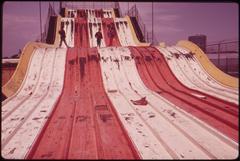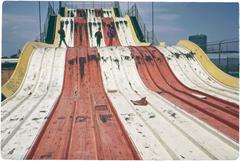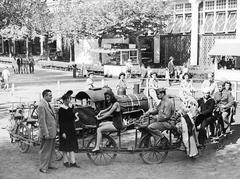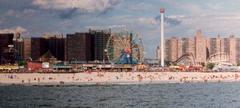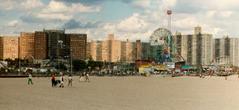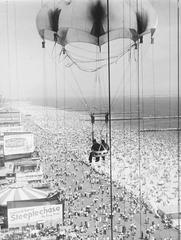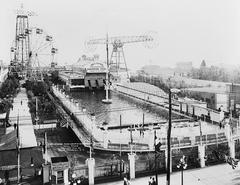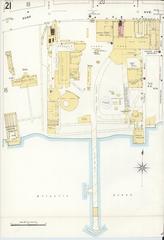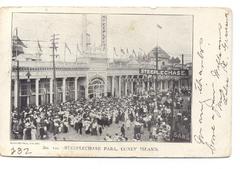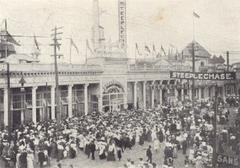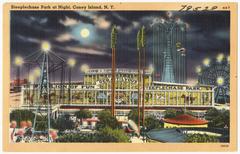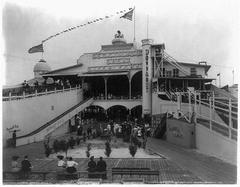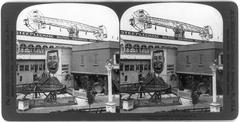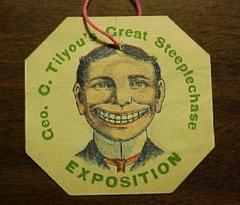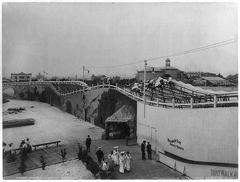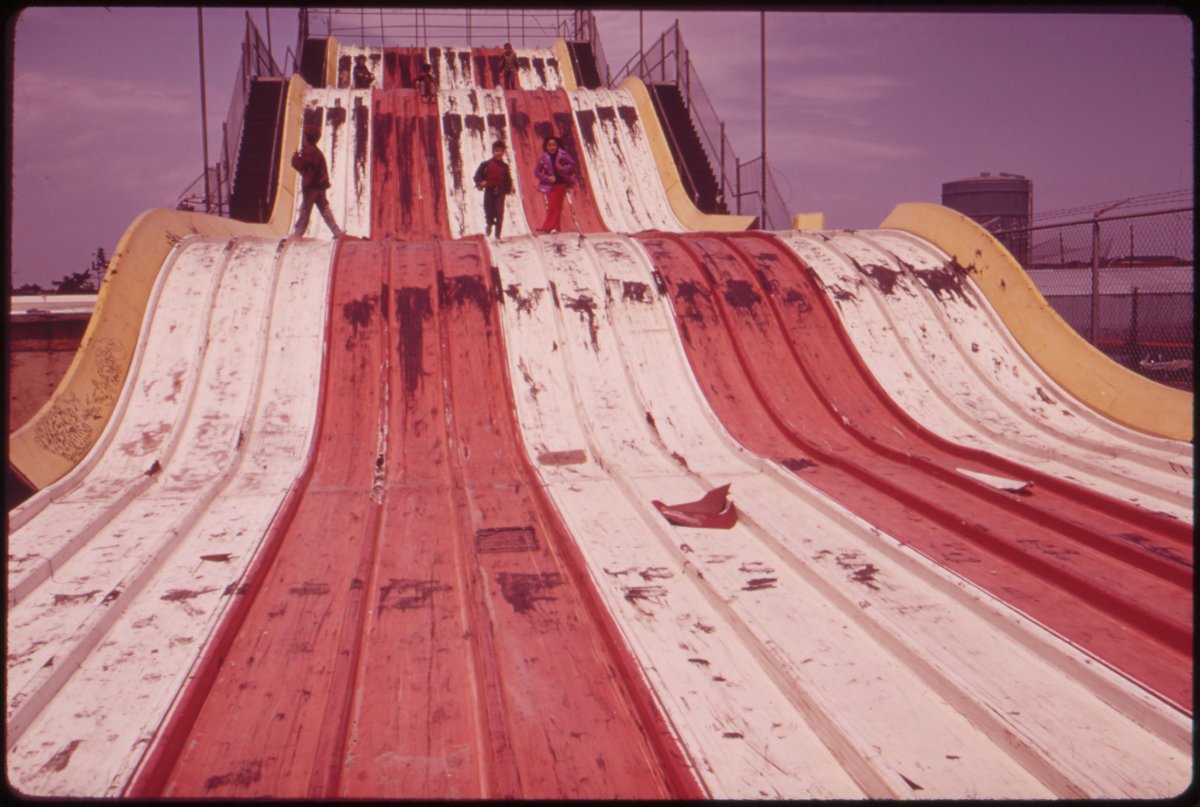
Steeplechase Park Visiting Hours, Tickets, and New York City Historical Sites Guide
Date: 14/06/2025
Introduction
Steeplechase Park, founded in 1897 by George C. Tilyou, was not only Coney Island’s first and longest-running amusement park but also a transformative site in the history of American leisure. As a pioneer of innovative rides and inclusive entertainment, Steeplechase Park helped shape Coney Island’s identity as “America’s Playground” and democratized recreation for millions of New Yorkers and visitors. While the original park ceased operations in 1964, its legacy endures through iconic landmarks like the Parachute Jump and through ongoing cultural memory, exhibitions, and guided tours. This detailed guide covers Steeplechase Park’s history, practical visitor information, accessibility, travel tips, and recommendations for exploring related attractions in Brooklyn’s famed boardwalk district (PBS; Carousel History; Atlas Obscura; USA History Timeline).
Contents
- Introduction
- Historical Overview
- Origins and Founding
- Growth, Attractions, and Innovations
- The 1907 Fire and Rebuilding
- Tilyou Family Legacy and Expansion
- Decline and Closure
- Cultural and Historical Significance
- Visiting Steeplechase Park Today
- Location and Accessibility
- Visiting Hours and Ticket Information
- Guided Tours and Special Events
- Photographic Highlights
- Frequently Asked Questions (FAQ)
- Visitor Tips and Recommendations
- Conclusion and Further Exploration
- Sources
Historical Overview
Origins and Founding
Steeplechase Park was established in 1897 by George C. Tilyou, who envisioned an innovative amusement park after witnessing the Ferris Wheel at the 1893 Chicago World’s Fair. Tilyou set out to create a site in Brooklyn that would combine thrilling attractions with accessible, affordable fun. The park’s signature mechanical Steeplechase Horse Race—where visitors “galloped” along undulating tracks on wooden horses—quickly became a symbol of the park’s playful spirit and technological ingenuity (PBS; Carousel History).
Growth, Attractions, and Innovations
From the outset, Steeplechase Park distinguished itself with a blend of mechanical marvels, participatory amusements, and a whimsical ethos. In addition to its namesake ride, early attractions included the Human Roulette Wheel, Human Pool Table, Hoop-La, and Panama Slide—interactive amusements designed to provoke laughter and camaraderie. The Blowhole Theater, featuring slapstick performances and playful pranks, cemented the park’s reputation as Coney Island’s “Funny Place” (Carousel History; Atlas Obscura).
Steeplechase Park’s innovations in ride design, crowd management, and themed entertainment made it a model for amusement parks nationwide. By the early 1900s, it was joined by Luna Park and Dreamland, establishing Coney Island as the epicenter of American amusement culture.
The 1907 Fire and Rebuilding
A devastating fire in 1907 destroyed most of Steeplechase Park. Tilyou, ever resourceful, charged admission to the ruins and rapidly rebuilt. The park’s 1908 reopening featured the Pavilion of Fun—a fireproof, year-round structure—and new attractions such as the Venetian Gondola ride and a vast outdoor saltwater pool, further enhancing its appeal and resilience (Carousel History).
Tilyou Family Legacy and Expansion
After George Tilyou’s death in 1914, the park was managed by his son Edward, who continued to expand its offerings. In 1941, the Parachute Jump—relocated from the 1939–40 New York World’s Fair—became a landmark attraction and remains an enduring symbol of Coney Island today (Carousel History).
Decline and Closure
The evolution of entertainment, the rise of suburban amusement parks, and changing urban demographics led to a gradual decline in attendance. Despite enduring through the postwar era, Steeplechase Park closed in 1964. The Pavilion of Fun was demolished in 1966, marking the end of an era. Today, the Parachute Jump stands as the sole surviving structure from the park (PBS).
Cultural and Historical Significance
Steeplechase Park not only shaped the future of amusement parks but also helped democratize leisure for people of all backgrounds. Its mascot, the iconic “Funny Face,” and its festive, inclusive atmosphere reflected New York City’s diversity and evolving social norms. The park’s influence continues to be felt in popular culture, urban planning, and the ongoing preservation of Coney Island’s unique identity (Atlas Obscura; USA History Timeline).
Visiting Steeplechase Park Today
While Steeplechase Park no longer operates as an amusement park, its historic site—now Steeplechase Plaza—remains a central gathering place on the Coney Island boardwalk. The Parachute Jump is a designated New York City landmark and a must-see for visitors.
Location and Accessibility
Steeplechase Plaza is located at the southern end of Coney Island’s boardwalk, near MCU Park and the Parachute Jump. The area is accessible via the D, F, N, and Q subway lines to Coney Island–Stillwell Avenue. Public buses also serve the district, and the neighborhood is pedestrian-friendly. The boardwalk and plaza are wheelchair accessible, with ramps and accessible restrooms (The Tourist Checklist).
Visiting Hours and Ticket Information
- Steeplechase Plaza: Open to the public year-round, 24 hours a day. No admission fee is required for the plaza, pier, or boardwalk.
- Nearby Amusement Parks: Luna Park and Deno’s Wonder Wheel operate seasonally (typically late spring through early fall), with hours usually from 11:00 AM to 10:00 PM during peak season. Tickets for rides and attractions are available online or on-site; wristband and pay-per-ride options are offered.
- MCU Park: Home to the Brooklyn Cyclones, the stadium hosts baseball games and events from June to September. Tickets are required for entry and available via the official website.
- Steeplechase Pier: Open daily, free of charge, perfect for strolling, fishing, and photography (Your Brooklyn Guide).
Guided Tours and Special Events
The Coney Island History Project offers walking tours and exhibitions detailing the history of Steeplechase Park and Coney Island’s broader amusement legacy. Seasonal events include the Mermaid Parade, fireworks displays, and themed festivals. Check institutional and park websites for the latest event schedules and tour information (Atlas Obscura).
Photographic Highlights
Top photo spots include:
- The illuminated Parachute Jump, especially at sunset or during light shows
- The historic Steeplechase Plaza entrance and public art installations
- Steeplechase Pier with panoramic views of the Atlantic Ocean
- The lively Coney Island boardwalk and adjacent Luna Park rides
Frequently Asked Questions (FAQ)
Q: Is Steeplechase Park open today?
A: The original amusement park is closed. However, Steeplechase Plaza and its public spaces are open daily, year-round.
Q: Are tickets required to visit?
A: No tickets are needed for the plaza, pier, or boardwalk. Tickets are required for nearby amusement parks, rides, and MCU Park events.
Q: Is the area accessible for visitors with disabilities?
A: Yes, the plaza, boardwalk, and nearby venues offer wheelchair access, ramps, and accessible restrooms.
Q: What is the best way to get to Steeplechase Plaza?
A: Take the D, F, N, or Q subway lines to Coney Island–Stillwell Avenue. The plaza is a short walk from the station.
Q: Are guided tours available?
A: Yes, the Coney Island History Project and local organizations offer tours focused on Coney Island’s historical sites, including Steeplechase Park’s legacy.
Visitor Tips and Recommendations
- Plan Ahead: Check seasonal hours for Luna Park, Deno’s Wonder Wheel, and MCU Park if you wish to enjoy rides or events.
- Arrive Early: Weekends and holidays are busiest; early mornings offer quieter photo opportunities.
- Pack Essentials: Bring cash for food stands, sunscreen, a hat, water, and a light jacket for cool evenings.
- Accessibility: Utilize boardwalk ramps and accessible restrooms if needed.
- Combine Attractions: Pair your visit with the New York Aquarium, Nathan’s Famous, or a stroll along the boardwalk for a full experience.
- Photography: The Parachute Jump and pier are ideal for both daytime and evening shots.
Conclusion and Further Exploration
Steeplechase Park’s legacy lives on as a vibrant public plaza, a historic landmark, and a source of inspiration for Coney Island’s ongoing cultural evolution. Whether you are a history enthusiast, family traveler, or photography lover, Steeplechase Plaza and the surrounding boardwalk offer an accessible gateway into NYC’s storied amusement heritage. Stay connected with the latest updates, events, and travel tips by downloading the Audiala app and following our official channels.
Sources
- PBS - Historic Highlights: Steeplechase Park
- Carousel History - Coney Island’s Steeplechase: Once America’s #1 Amusement
- Atlas Obscura - Coney Island History
- USA History Timeline - A Historical Perspective of America’s Playground
- Voyage NY - Exploring the Historic Amusement Park and Iconic Boardwalk
- The Tourist Checklist - Coney Island Guide
- Untapped Cities - Fred Trump’s Demolition of Coney Island Steeplechase Pavilion Exhibit
- Your Brooklyn Guide - Things to Do at Coney Island
